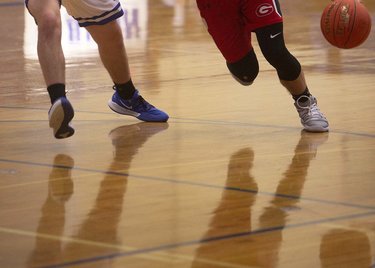GCSD mulls $105M budget for next year with levy up to limit: 1.28%
GUILDERLAND — The school district here has drafted a $105 million budget for next year and is looking for residents’ response.
The spending plan is up 1.81 percent from this year — about $1.9 million more. The draft calls for a levy of $75,953,398, which would be exactly at the state-set limit — for an increase of 1.28 percent in taxes.
That means, when voters go to the polls on May 18, a simple majority is needed to pass the budget. If a school budget goes over the levy limit — which is low this year because the Consumer Price Index is below the 2-percent cap — a supermajority vote is needed.
Over the last six years, since the state set a levy limit, Guilderland has always stayed under it and passed its budgets by a two-thirds affirmative vote or more.
While Guilderland is being allocated $2.5 million from the $1.9 trillion American Rescue Plan, 20 percent of which must be spent on making up for learning lost during the pandemic, the district’s current budget proposal does not spend those funds, which will be dispersed over several years.
Rather, the Guilderland budget is built on the funding proposed by Governor Andrew Cuomo in his executive budget. As is typical for Guilderland, about a quarter of its revenues come from state and federal aid.
“I see this as a budget that’s trying to balance hope with uncertainty,” said Superintendent Marie Wiles in the midst of a lengthy and detailed budget presentation to the school board on Tuesday night.
“We’ve made a plan here that puts students first,” Wiles went on. “We’re looking at the long run; it’s not the short race.”
Wiles said the budget is respectful of taxpayers as “the pandemic hurt people unequally.” She also said, “Everyone has been through trauma” although the schools won’t know the full needs of students and staff until fall.
Wiles displayed a photograph of a rainbow taken by Emily Mineau, a member of what was called the Re-Entry Committee — charting a course for Guilderland schools to open in the midst of the pandemic — and is now called the Recovery Committee.
“The rainbow is a sign of hope,” said Wiles. “The storm has passed but you always kind of wonder what’s on the other side of that, right? …. It’s a perfect symbol of where we are right now.”
Gloria Towle-Hilt, the school board’s vice president, said she likes the way the proposal mirrors comments made through a ThoughtExchange.
A new ThoughtExchange — an online forum where residents, staff, and students can share their views — was launched Tuesday night to get comments on the draft before the board discusses it further next Tuesday, March 30.
“I think we’re honoring the community,” said Towle-Hilt.
“Sustaining what we have”
The desires reported from parents, staff, and students had many areas of overlap.
Parents had wanted to maintain low class size and academic programs, to focus on staff and student mental health, and to offer as much in-person learning as possible.
Faculty and staff also wanted to maintain low class sizes, and maintain course offerings such as art and music, continue to focus on students’ mental health, and to be offered an early retirement incentive.
Students wanted to focus on their mental health, to have a curriculum that is “real life” and culturally responsive, to improve Wi-Fi and access to new Chromebooks, and to change the start and end times of the school day.
“This is a budget about sustaining what we have,” said Wiles.
Students this year were given a choice of attending school in person or remotely. Classes were configured so students were six feet apart. All elementary students could attend classes daily.
To make space for this, fifth-graders at the district’s five elementary schools were shifted to the middle school, and eighth-graders were shifted to the high school. High school students had a hybrid schedule, alternating in-person with online learning.
Next year’s budget assumes all students will attend school all day, every day. Fifth-grade students and staff will return to the elementary schools and eighth-graders will return to the middle school.
Many parents requested that the small class sizes of 14 students continue, Wiles said, but this is not physically possible she explained; the current configuration was to keep students six feet apart.
The Centers for Disease Control and Prevention has recently reduced its guidance for school distancing from from six to three feet but New York State has not yet changed its guidance from six feet.
Class sizes — contingent on state guidance — will return to the district’s original guidelines: For kindergarten, first and second grades, 18 to 23 students; for third, fourth, and fifth grades, 21 to 25 students; for sixth, seventh, and eighth grades, 24 to 26 students; and high school classes would range from 15 to 30 students.
The length of the school day at Guilderland will return to normal next year although the start times will shift due to a long-anticipated change to allow high school students a later start.
All students and staff will likely continue to wear masks.
State and federal funds
Tuesday’s budget sesion, held as a video conference, started with comments from Assemblywoman Patricia Fahy who described the current state budget talks, which are always intense leading up to the April 1 deadline for adoption, as “a rollercoaster extraordinaire.”
Legislators, in addition to the budget, have had to deal with “scandal after scandal,” she said, alluding to sexual harassments allegations against Cuomo as well as criticisms of his handling of nursing homes during the pandemic, leading to investigation by the Attorney General’s Office as well as a State Assembly committee looking at impeachment.
The one-house plan that the State Assembly and State Senate have proposed differs from Cuomo’s proposal to hold Foundation Aid flat for the second year in a row, to consolidate expense aids into a Services Aid block grant, and to create a Local District Funding Adjustment state-aid cut.
The legislators’ plan instead would increase Foundation Aid to schools by $1.4 billion for a minimum 2-percent increase for every school district so that each district would get at least 60 percent of its formula amount. Also, there would be a three-year phase-in so all districts are fully funded by the 2023-24 school year.
The legislators’ plan would also allow for more flexibility for fund balance — a district’s rainy-day account — raising the limit from the current 4 percent of the district’s budget. The Assembly proposes raising the cap to 6 percent through 2022-23 and the Senate proposes raising the cap to 8 percent through 2024-25.
Fahy called the Biden stimulus package “unprecedented.” New York State is receiving $9 billion from the American Rescue Plan for kindergarten through 12th-grade education as well as $12.5 billion in direct aid for state purposes.
The rescue funds — $2.5 million for Guilderland — will be available through Dec. 31. 2024. In addition to addressing learning loss, the money can be spent on mental-health support for students, after-school and summer learning programs, hardware and software for remote learning, air quality and ventilation improvements, preparedness efforts, and planning for school closures.
The federal legislation was written so that the money would go directly to municipalities and school districts, Fahy said.
She shared a comment made earlier in the day by Senate Majority Leader Charles Schumer — a New York Democrat — who shepherded the American Rescue Plan through the Senate, a bill which passed without a single Republican vote.
“When you give the money to Albany, they never see it,” Fahy quoted Schumer as saying, meaning the funds don’t get to the schools and municipalities.
Fahy said she made the case that all $2.5 million should go to the district. “I think we’ve been heard loud and clear,” she said.
Late in Tuesday night’s budget session, Guilderland School Board member Kelly Person asked why the district’s 2021-22 budget proposal didn’t reflect the big federal increases.
“Where is that money going?” she asked.
“Huge portions of our state aid is backfilled with previous federal dollars …,” Wiles responded. “We have $4 million put in and almost $4 million taken out. So we have the potential next year, if that $4 million is taken out and is not plugged by additional something — whether federal dollars or renewed local state funds —we’re going to have a huge hole to fill.”
Wiles recalled the dilemma for New York schools a decade ago in the midst of “a terrible economic downturn,” when the state, short on revenue, used money that had been meant for school aid. “And we got the Gap Elimination Adjustment and we laid off 229 people over two or three years,” she said.
“So, right now, as of tonight, we’re promised this $2.5 million but we don’t know how much of the actual state aid coming our way for next year will be federally provided money to close a state funding gap or not.”
Guilderland’s stance, then, for the $2.5 million from the federal stimulus packages is it may likely be needed “just to maintain the status quo” in the next several years, wiles said. “It would be a disaster to spend it all and then we wouldn't have any money. There’s no money to replace it once you spend it. It’s one time.”
Neil Sanders, Guilderland’s assistant superintendent for business, said the “key piece” is: How much is the federal money going to be offset by a reduction in state aid?
Person asked if the district had a priority list or a wish list on how to spend the one-time federal funds.
Wiles said, “We would love to expand our literacy coaching model.” She also mentioned summer programs and other initiatives to help students who had struggled during the pandemic.
“We can’t spend it all on a couple of programs for one or two years because then the money will be gone and we’ll have hired people that we can no longer pay,” Wiles said.
She concluded, “It’s like people who won the lottery and, five years down the road, they’re completely broke.”
Numbers
Guilderland currently has 4,824 students enrolled and has 932 employees — 710 full-time and 222 part-time.
Teachers, at 498, make up the largest share of employees, followed by support staff, at 407, and administrators and supervisors, at 27.
The greatest share of the proposed $104,895,570 budget — close to 80 percent — goes to pay for salaries and benefits.
“We’re a people industry …,” said Sanders, in giving an overview of expenses. “We have a lot of staff that needs to be there to assist children in learning and growth.”
The biggest change in expenses is for employee salaries and benefits. The draft shows close to $600,000 being added to the $45.7 million spent on professional salaries. Another $390,000 is to be added to the $10.8million currently spent on support-staff salaries.
Close to $1 million more is to be added to the $27.3 million spent on employee benefits.
Enrollment is expected to decrease, by 14 students, next year. Thirty-nine new students are expected at the elementary level, while the middle school anticipates a drop of three students and the high school is expected to have 56 fewer students.
Because of the drop in high school enrollment, which is expected to continue, the budget proposes reducing sections of social studies, math, science, music, physical education, and art.
With these savings, it plans to restructure an assistant-principal post at the high school, which was left vacant when Amy Hawrylchak became principal of Tech Valley High School.
The plan is to have seven-tenths of the job “support the overall function of the school” — Wiles said there have been few disciplinary problems during the pandemic but those duties will return when students return — and three-tenths of the job help with “efforts related to equity, diversity, inclusivity, and anti-racism.”
In the wake of George Floyd’s death and the protests that followed, the Guilderland School Board appointed a task force to look at equity issues.
Sanders displayed a chart showing that Guilderland, among the 13 Suburban Council school districts, has the lowest fund balance as a percentage of revenue — 11.24 percent. The highest is over 31 percent.
Sanders says that Guilderland should have more in reserves. “Fourteen-million dollars in a $100 million budget is not unduly large,” he said.
He noted that less in savings brings down the district’s bond rating, which makes borrowing more expensive, and it is also a signal to the state of potential fiscal stress.
“The ability to keep more in the fund balance,” Sanders said, “would be helpful going forward to provide a suction to help us through difficult times.”



